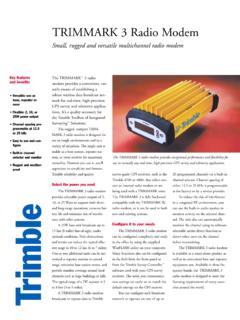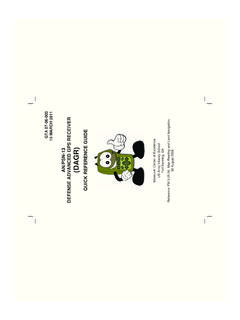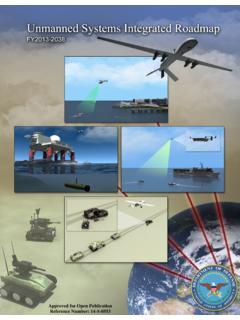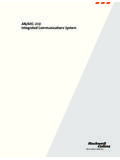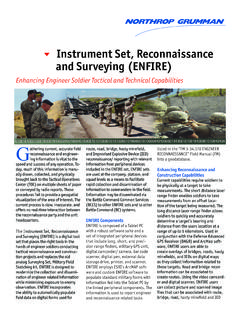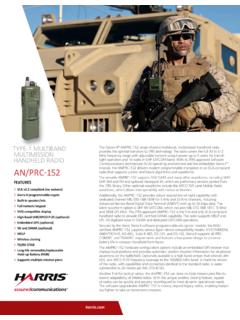Transcription of GPS Errors & Estimating Your Receiver's Accuracy
1 GPS Errors & Estimating your Receiver's Accuracy What's the difference between repeatability and Accuracy ? Accuracy The degree of conformance between the estimated or measured position, time, and/or velocity of a gps receiver and its true time, position, and/or velocity as compared with a constant standard. Radionavigation system Accuracy is usually presented as a statistical measure of system error and is characterized as follows: Predictable - The Accuracy of a radionavigation system's position solution with respect to the charted solution. Both the position solution and the chart must be based upon the same geodetic datum. Repeatable - The Accuracy with which a user can return to a position whose coordinates have been measured at a previous time with the same navigation system. Relative - The Accuracy with which a user can measure position relative to that of another user of the same navigation system at the same time. Estimated Position Error (EPE) EPE (1-sigma) = HDOP * UERE (1-sigma) Multiplying the HDOP * UERE * 2 gives EPE (2drms) and is commonly taken as the 95% limit for the magnitude of the horizontal error.
2 The probability of horizontal error is within an ellipse of radius 2 drms ranges between and depending on the ratio of the ellipse semi-axes. User Equivalent Range Error (UERE) is computed in the tables lower on this page. Estimate the Accuracy of your gps receiver by following these four steps. A set of measurements is worth a thousand expert opinions! Forget about EPEs! Trust your own plot. any convenient unobstructed place. the UTM coordinates for that place. Don't throw out ANY data points! a graphic plot of Eastings and Northings (pencil and paper works really well for this). steps 2 and 3 (at different time of day and night, and often) Notes from Wolfgang Rupprecht: 1. It might induce more folks to actually do the experiment themselves if the lead in paragraph were to be something along the lines of "If things were working well and everything followed the theoretical models then these are the Errors one would expect to " The difference in my mind is that from a strictly scientific standpoint one really can't assume that any of the information transmit from the satellites is correct or that anything the GPS is calculating is correct.
3 It obviously usually is, but there are low-probability exceptions. 2. The other thing that deserves being stressed is that there are two kinds of " Accuracy " numbers being tossed around. One is actual meausred Accuracy . This is what the GPS system does (or at least did) during the period of the test. The other are target-spec numbers. These are back-of-the-envelope error budgets that the designers have set aside. They might be overly pessimistic outside numbers, they might be overly optimistic. Only real measurements over extended periods of time can tell. 3. I'd like to see everyone build or buy a gps-to-computer cable and log their own NMEA. There is no substitute for checking the numbers oneself. Notes from David L Wilson: 1. Suggest you add something like: The more days and more times per day, the better. 2. Suggest something about the fact that, in general, maximum Errors will be larger than those observed. This is due to the fact that large Errors are brief and unpredictable.
4 I would definitely include something to this effect. 3. Suggest that if someone is able to log the NMEA data that that is preferred and that what you propose is for those unable to do that or not possesing the software or experience with it to do differently. Maybe you do not have to say that much. 4. Strongly caution that if the person seems to have very different numbers from other that they should be suspicious that they did not collect enough data or that due to probability, they were just lucky or unlucky. Page 1 of 8 Sam Wormley's GPS Errors & Estimating your Receiver's Accuracy The following is adapted from Chapter 11, "GPS Error Analysis", pages 478-483, Global Positioning System: Theory and Applications by Bradford W. Parkinson, James J. Spilker Jr. Eds. A. Six Classes of Errors Ranging Errors are grouped into the six following classes: 1) Ephemeris data-- Errors in the transmitted location of the satellite 2) Satellite clock-- Errors in the transmitted clock, including SA 3) Ionosphere-- Errors in the corrections of pseudorange caused by ionospheric effects 4) Troposphere-- Errors in the corrections of pseudorange caused by tropospheric effects GPS SPS Performance Standard (Oct 2001) FAA GPS SPS Performance Analysis Report (Jan 2001) USFS GPS Information Page & receiver Performance Reports, Including Performance Under Canopy o Garmin and Magellan Recreational GPS receivers o Trimble GeoExplorer 3 o Trimble Pathfinder Pro XRS o Rockwell PLGR 96 PPS Navigation Accuracy Reports GPS Accuracy Web Pages from the National Geodetic Survey (NGS) GPS Accuracy Monitor by Dennis Milbert Garmin 12XL Accuracy Report by John Bonde Garmins 25LP OEM receiver Tested by Storm Van Leeuwen S.
5 Garmin Accuracy Report by Wolfgang Rupprecht GPS Accuracy Web Pages by David L. Wilson, present measured data and mathematical modeling pertaining to GPS Accuracy . Visits to a survey marker or short GPS observations will not provide a useful appraisal of GPS Accuracy . Estimation of Trimble Scoutmaster DGPS Performance (1997) by Sam Wormley Page 2 of 8 Sam Wormley's GPS Errors & Estimating your Receiver's Accuracy5) Multipath-- Errors caused by reflected signals entering the receiver antenna 6) receiver -- Errors in the Receiver's measurement of range caused by thermal noise, software Accuracy , and interchannel biases Each class is briefly discussed in the following sections. Representative values for these Errors are used to construct an error table in a later section of this chapter. A more complete discussion of individual error sources can be found in succeeding chapters. B. Ephemeris Errors Ephemeris Errors result when the GPS message does not transmit the correct satellite location.
6 It is typical that the radial component of this error is the smallest: the tangential and cross-track Errors may be larger by an order of magnitude. Fortunately, the larger components do not affect ranging Accuracy to the same degree. This can be seen in the fundamental error Eq. (12). The AW represents each satellite position error, but when dot-multiplied by the unit satellite direction vector (in the A matrix), only the projection of satellite positioning error along the line of sight creates a ranging error. Because satellite Errors reflect a position prediction, they tend to grow with time from the last control station upload. It is possible that a portion of the deliberate SA error is added to the ephemeris as well. However, the predictions are long smooth arcs, so all Errors in the ephemeris tend to be slowly changing with time. Therefore, their utility in SA is quite limited. As reported during phase one, (Bowen, 1986) in 1984,[5] for predictions of up to 24 hours, the rms ranging error attributable to ephemeris was m.
7 These Errors were closely correlated with the satellite clock, as we would expect. Note that these Errors are the same for both the P- and C/A-codes (see Chapter 16 of this volume for a more detailed discussion of ephemeris and clock Errors ). C. Satellite Clock Errors Fundamental to GPS is the one-way ranging that ultimately depends on satellite clock predictability. These satellite clock Errors affect both the C/A- and P-code users in the same way. The error effect can be seen in the fundamental error Eq. (11) as delta-B. This effect is also independent of satellite direction, which is important when the technique of differential corrections is used. All differential stations and users measure an identical satellite clock error. A major source of apparent clock error is SA, which is varied so as to be unpredictable over periods longer than about 10 minutes. The rms value of SA is typically about 20 m in ranging, but this can change after providing appropriate notice, depending on need.
8 The Air Force has guaranteed that the twodimensional rms (2 DRMS) positioning error (approximately 90th percentile) will be kept to less than 100 m. This is now a matter of federal policy and can only be changed by order of the President of the United States. [Note that SA was removed May 2, 2000 @4:05 UTC.] More interesting is the underlying Accuracy of the system with SA off. The ability to predict clock behavior is a measure of clock quality. GPS uses atomic clocks (cesium and rubidium oscillators),' which have stabilities of about I part in 10E13 over a day. If a clock can be predicted to this Accuracy , its error in a day (~10E5 s) will be about 10E-8 s or about m. The experience reported in 1984 was m for 24-hour predictions. Because the standard deviations of these Errors were reported to grow quadratically with time, an average error of 1-2 m for 12-hour Page 3 of 8 Sam Wormley's GPS Errors & Estimating your Receiver's Accuracyupdates is the normal expectation.
9 D. Ionosphere Errors Because of free electrons in the ionosphere, GPS signals do not travel at the vacuum speed of light as they transit this region. The modulation on the signal is delayed in proportion to the number of free electrons encountered and is also (to first order) proportional to the inverse of the carrier frequency squared (1/f squared). The phase of the radio frequency carrier is advanced by the same amount because of these effects. Carrier-smoothed receivers should take this into account in the design of their filters. The ionosphere is usually reasonably well-behaved and stable in the temperate zones; near the equator or magnetic poles it can fluctuate considerably. An in-depth discussion of this can be found in Chapter 12, this volume. All users will correct the raw pseudoranges for the ionospheric delay. The simplest correction will use an internal diurnal model of these delays. The parameters can be updated using information in the GPS communications message (although the Accuracy of these updates is not yet clearly established).
10 The effective Accuracy of this modeling is about 2-5 m in ranging for users in the temperate Zones. A second technique for dual-frequency P-code receivers is to measure the signal at both frequencies and directly solve for the delay. The difference between L1 and L2 arrival times allows a direct algebraic solution. This dual-frequency technique should provide 1-2 m of ranging Accuracy , due to the ionosphere, for a well-calibrated receiver . A third technique is to rely on a near real-time update. An example would be the proposed Wide Area Differential GPS system (WADGPS). This should also produce corrections with accuracies of 1-2 m or better in the temperate zones of the world. E. Troposphere Errors Another deviation from the vacuum speed of light is caused by the troposphere. Variations in temperature, pressure, and humidity all contribute to variations in the speed of light of radio waves. Both the code and carrier will have the same delays. This is described further in the chapter devoted to these effects, Chapter 13 of this volume.
